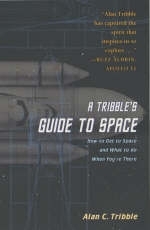
A Tribble's Guide to Space
How to Get to Space and What to Do When You are There
Seiten
2002
Princeton University Press (Verlag)
978-0-691-02763-0 (ISBN)
Princeton University Press (Verlag)
978-0-691-02763-0 (ISBN)
- Titel ist leider vergriffen;
keine Neuauflage - Artikel merken
Offers a guide to space exploration, from how to get there to how to phone home and how to survive the harsh environment of space. This book uses examples from space missions, both factual and fictional, and tackles real-world problems encountered in space exploration. It is intended for those with an interest in space exploration.
Space - the final frontier. It's as little as fifty miles away, and yet it is considered one of the most dangerous and remote of places. Popular television shows such as "Star Trek" and movies such as "Apollo 13" and "October Sky" have fired the imaginations of would-be explorers. Alan Tribble has worked on the design and development of dozens of spacecraft, including the Space Shuttle and the International Space Station. "A Tribble's Guide to Space" is a how-to book that is firmly grounded in the realities of current state-of-the-art space engineering while tapping into the power of imagination that drives us to explore. Alan Tribble offers a delightful guide to the nuts and bolts of space exploration, from how to get there to how to phone home and how to survive the harsh environment of space. Using examples from famous space missions, both factual and fictional, Tribble tackles fascinating real-world problems encountered in space exploration. Why do submarine hatches open inward and spacecraft hatches open outward? What do curveballs and satellites have in common? Why did Scotty, the chief engineer of the fictional USS Enterprise, always 'need more power?'
Why did the fire that destroyed Apollo I on the launch pad burn so furiously that no one could react fast enough to save the lives of the crew? In answering these questions, Tribble examines getting to space, from the physics of motion to the practical implications of Einstein's theory of relativity. He explores the basics of spaceships and starships, from power usage to navigation - all from the viewpoint of a spacecraft designer. This book describes rocket science and more in a manner that captures the common excitement shared by anyone with an interest in space exploration. Armchair astronauts, engineers who work in a space company and anyone who has looked up at the sky and wondered how we will get there will find reading this book a wonderful and enlightening experience.
Space - the final frontier. It's as little as fifty miles away, and yet it is considered one of the most dangerous and remote of places. Popular television shows such as "Star Trek" and movies such as "Apollo 13" and "October Sky" have fired the imaginations of would-be explorers. Alan Tribble has worked on the design and development of dozens of spacecraft, including the Space Shuttle and the International Space Station. "A Tribble's Guide to Space" is a how-to book that is firmly grounded in the realities of current state-of-the-art space engineering while tapping into the power of imagination that drives us to explore. Alan Tribble offers a delightful guide to the nuts and bolts of space exploration, from how to get there to how to phone home and how to survive the harsh environment of space. Using examples from famous space missions, both factual and fictional, Tribble tackles fascinating real-world problems encountered in space exploration. Why do submarine hatches open inward and spacecraft hatches open outward? What do curveballs and satellites have in common? Why did Scotty, the chief engineer of the fictional USS Enterprise, always 'need more power?'
Why did the fire that destroyed Apollo I on the launch pad burn so furiously that no one could react fast enough to save the lives of the crew? In answering these questions, Tribble examines getting to space, from the physics of motion to the practical implications of Einstein's theory of relativity. He explores the basics of spaceships and starships, from power usage to navigation - all from the viewpoint of a spacecraft designer. This book describes rocket science and more in a manner that captures the common excitement shared by anyone with an interest in space exploration. Armchair astronauts, engineers who work in a space company and anyone who has looked up at the sky and wondered how we will get there will find reading this book a wonderful and enlightening experience.
Alan C. Tribble is a rocket scientist who has spent over ten years designing dozens of spacecraft for various missions. Formerly with Rockwell International's Space Systems Division, he is now a speaker and author on space-related subjects. His other books include "The Space Environment" and the "Princeton Guide to Advanced Physics".
Preface vii Acknowlegments xi To Infinity and Beyond: A Brief History of Space 3 Beam Me Up: Getting to Space 27 A Space Odyssey: Spaceships and Starships 67 Out of This World: The Environment of Space 107 To Boldly GO: The Reasons for Space Exploration 139 The Shape of Things to Come 165 For Furture Reading 169 Index 171
| Erscheint lt. Verlag | 1.9.2002 |
|---|---|
| Zusatzinfo | 13 color plates |
| Verlagsort | New Jersey |
| Sprache | englisch |
| Maße | 152 x 235 mm |
| Gewicht | 312 g |
| Themenwelt | Sachbuch/Ratgeber ► Natur / Technik ► Weltraum / Astronomie |
| ISBN-10 | 0-691-02763-3 / 0691027633 |
| ISBN-13 | 978-0-691-02763-0 / 9780691027630 |
| Zustand | Neuware |
| Haben Sie eine Frage zum Produkt? |
Mehr entdecken
aus dem Bereich
aus dem Bereich
die Suche nach der Urkraft des Universums
Buch | Hardcover (2023)
Klett-Cotta (Verlag)
25,00 €
Perspektiven auf die Menschheit
Buch | Hardcover (2024)
Klett-Cotta (Verlag)
25,00 €


